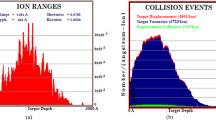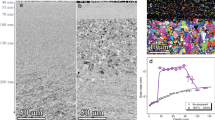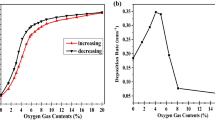Abstract
Dislocation loops and stacking fault formation mechanism in α–Si3N4 have been studied by annealing α–Si3N4 powders at 1500 °C and 1750 °C. Thermally activated vacancies and the structural vacancies generated with replacement of nitrogen by oxygen have been tentatively suggested to be two sources of vacancies in α–Si3N4. From the point of view of mechanism, incorporation of these vacancies is believed to lie at the building-up stage of α–Si3N4 lattice. As a result of the vacancies agglomeration, dislocation loops and stacking faults seem to be a distinctively structural feature of α–Si3N4 fabricated by different routes [chemical vapor deposition (CVD), silicon nitridation, silica carbothermal reduction, and imide decomposition]. A general discussion has been extended to the historical controversy over the oxygen and vacancy stabilization of α–Si3N4 lattice arisen from the fact that the observed unit cell dimension of α–Si3N4 has a wide variation, and also to some related phenomena in processing of Si3N4.
Similar content being viewed by others
References
K. H. Jack, in Progress in Nitrogen Ceramics, edited by F. L. Riley (Martinus Nijhoff, The Hague, The Netherlands, 1983), pp. 45–60.
M. N. Rahaman, Y. Boiteux, and L. C. Dejonghe, Bull. Am. Ceram. Soc. 65, 1171–1176 (1986).
C. M. Wang and F. L. Riley, J. Euro. Ceram. Soc. 10, 83–93 (1995).
C. M. Wang, F. L. Riley, F. Castro, and I. Iturriza, J. Am. Ceram. Soc. 76, 2136–2138 (1993).
C. M. Wang, J. Am. Ceram. Soc. 78, 3393–3396 (1995).
K. L. Moore, Pro. Electron Microsc. Soc. America 49, 936–937 (1991).
H. Suematsu, J. J. Petrovic, and T. E. Mitchell, Pro. Electron Microsc. Soc. America 50, 342–344 (1992).
R. M. J. Cotterill, M. Doyama, J.J. Jackson, and M. Meshii, Lattice Defects in Quenched Metals (Academic Press, New York, 1965).
A. G. Evans and J. V. Sharp, J. Mater. Sci. 6, 1292–1302 (1971).
S. Hampshire, H. K. Park, D. P. Thompson, and K. H. Jack, Nature (London) 274, 880–882 (1978).
S. Wilde, P. Grieveson, and K. H. Jack, Special Ceramics 5, 385–395 (1972).
W. Jäger, M. Rühle, and M. Wilkens, Phys. Status Solidi A 31, 525–533 (1975).
X. Q. Pan, unpublished work.
K. Kato, Z. Inoue, K. Kijima, I. Kawada, H. Tanaka, and T. Yamane, J. Am. Ceram. Soc. 58, 90–91 (1975).
S. L. Hwang and I.W. Chen, J. Am. Ceram. Soc. 77, 1711–1718 (1994).
F. Wakai, Y. Kodama, S. Sakaguti, N. Murayama, K. Izaki, and N. Niihara, Nature (London) 344, 421–423 (1990).
Author information
Authors and Affiliations
Rights and permissions
About this article
Cite this article
Wang, CM., Pan, XQ. & Rühle, M. Origin of dislocation loops in α-silicon nitride. Journal of Materials Research 11, 1725–1732 (1996). https://doi.org/10.1557/JMR.1996.0216
Received:
Accepted:
Published:
Issue Date:
DOI: https://doi.org/10.1557/JMR.1996.0216




